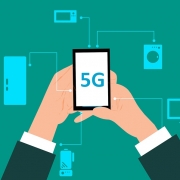RF Device Revolution In the 5G Era
1 RF device is the core foundation of wireless connectivity
1.1 RF device is a converter between the two-level digital signal and electromagnetic wave signal
Radio frequency devices are the basic components of wireless communication devices. They play two important roles in wireless communication, that is, in the process of transmitting signals, they play the role of converting binary signals into high-frequency wireless electromagnetic signals; in the process of receiving signals The electromagnetic wave signal received by the center is converted into a binary digital signal.
Regardless of the communication protocol, the communication frequency used is high or low, and configuring the RF device module is a necessary basic component of the system. Whether using the 13.56Mhz signal as the transmission carrier NFC system; or the GSM communication system using the 900/1800Mhz signal as the transmission carrier; or the unmanned millimeter-wave radar using the 24Ghz and 77Ghz electromagnetic wave signals as the transmission carriers, all need to be configured with RF Device module. As an indispensable part of wireless communication, the technological innovation of RF devices is one of the core engines that drive the development of wireless connectivity. In the environment of large-scale growth of networked devices, the RF device industry is the fastest growing and most directional asset in the future.
The world of the future is a world of wireless connectivity. According to Gartner’s forecast, by 2020, the number of connected devices will reach 25 billion, achieving an average of three connected devices per person worldwide. According to Gartner, in 2015, there were only 2.9 billion connected devices in the global consumer industry; only 736 million connected devices in industrial applications. With the megatrend of wireless networking devices increasing from 3.6 billion in 2015 to 25 billion, the annual output value of RF devices will increase several times.
1.2 The market size reached 11 billion US dollars, and the industry maintained double-digit high-speed growth.
In 2015, the global mobile terminal RF device market was about 11 billion US dollars. According to Qualcomm’s forecast, the RF front-end module of mobile terminals will have a compound growth rate of more than 13% between 2015 and 2020, and the market size will exceed 18 billion US dollars by 2020.
The RF front-end module market has grown strongly. On the one hand, global 4G terminal shipments accounted for just over 50% of shipments in 2015, and the increase in penetration rate guarantees growth momentum in the next two years. On the other hand, in the evolution of 4G to 5G, the complexity of RF devices is gradually increasing, and the value of single-cell mobile phones for RF devices will be improved.
2 The wireless connection needs more than ever, RF equipment industry opportunities continue
With the increasing number of wireless connection protocols supported by terminals, from the original 2G network to the current NFC, 2G/3G/4G network, WiFi, Bluetooth, FM, etc., the value of the single-machine RF device of the communication terminal has increased several times. Looking into the future, the penetration rate of 4G is not saturated, and the increase in penetration rate will continue to drive the growth of the single-machine value of RF devices. In addition, 5G communication brings new growth opportunities for the RF device industry. On the one hand, the number of frequency bands that the RF module needs to process is greatly increased. On the other hand, the signal processing difficulty of the high-frequency band is increased, and the system requirements for filter performance are also greatly improved.
2.1 The penetration rate of LTE terminal equipment is increased, and the value of single-machine of RF equipment is boosted.
In the early GSM mobile phones, the value of a single mobile phone for RF devices was less than US$1. In the 4G era, the value of the single-chip RF devices of Apple and Samsung’s high-end flagship models exceeded US$12.75. The value of stand-alone devices has increased over the past decade. Times.
The conversion of 3G terminals to 4G terminals has doubled the value of single machines. According to the prediction of the US RF device giant Triquent, entering the 4G era, the value of a single mobile phone RF device has increased from 3.75 US dollars to 7.5 US dollars for 3G terminals, and the ASP for global roaming terminal devices has even reached 12.75 US dollars.
2.2 Global LTE terminal penetration rate is between 50-60%
4G terminal penetration is not saturated. According to data from Taiwan’s GaAs foundry giant Win Semiconductor and US Qorvo, the penetration rate of global 4G communication terminal equipment reached 54% in 2015 and is expected to reach 74.5% in 2019.
2.3 5G technology upgrades, RF devices welcome innovation opportunities
5G communication In order to achieve the upgrade of communication speed and capacity, there are three major changes in technology: one is to use more communication frequency bands; the other is to use MIMO multi-antenna technology; the third is to use carrier aggregation technology.
2.3.1 Add more than 50 frequency bands by 2020 to drive RF filter opportunities
In the LTE R11 version proposed by the 3GPP Standards Association 3GPP in 2012, the number of frequency bands that cellular communication systems need to support has increased to 41. According to the RF device giant Skyworks, by 2020, the number of frequency bands supported by 5G applications will double, and more than 50 communication bands will be added. The total number of bands supported by global 2G/3G/4G/5G networks will reach 91 or more.
In theory, two filters are required for RF signal processing in a single band. Since multiple filters are integrated into the filter bank, the relationship between the filter device and the number of bands configured in the handset is not a simple linear proportional relationship. However, after the frequency band increases, the difficulty of filter design and the large increase in the number of filters are certain trends, and the corresponding value and sales volume will be several times that of the current filter.
As far as practical applications are concerned, mobile phones sold in the domestic market generally support five-mode and thirteen-frequency, that is, the number of supported frequency bands is 13. In the past, domestic 2G mobile phones only need to support 4 frequency bands, 3G mobile phones support at least 9 frequency bands, and the number of supported frequency bands has been greatly improved in each generation communication system upgrade process.
The US FCC (Federal Communications Commission) delineated the 5G frequency band in July this year and is the first country in the world to determine the spectrum of the 5G high-frequency band. The US 5G communication frequency band includes 3.85Ghz, 7Ghz, 27.5-28.35 Ghz, 37-38.6 Ghz, 38.6-40 Ghz, 64-71 Ghz. From the perspective of the 5G frequency band delineated by the United States, the newly added frequency bands are concentrated in the low, medium and high-frequency bands of 3.8-7Ghz, 27-40Ghz and 64-71Ghz. The performance requirements of the filter in the high-frequency band are more demanding, and the filter industry Faced with a new technological revolution from materials to manufacturing processes.
2.3.2 MIMO technology brings RF antenna opportunities
MIMO technology refers to the communication technology in which multiple transmitting and receiving antennas are used at the transmitting end and the receiving end of the signal. MIMO technology has doubled the rate and capacity of communication and is one of the key technologies for LTE and future 5G. The popularity of MIMO technology has brought a huge incremental market to the antenna industry, and base stations and terminal antennas are welcoming fast-growing industry opportunities.
In order to improve the communication rate, it is expected that by 2020, MIMO64x8 will become the standard configuration, that is, the base station side adopts 64 antennas, and the mobile terminal adopts eight antennas configuration mode. At present, most mobile phones on the market only support MIMO2x2 technology. If MIMO64x8 technology is adopted, the number of base station antennas needs to be increased by 31 times, and the number of mobile antennas needs to be increased by three times.
2.3.3 Carrier Aggregation Brings RF Switching and Filter Opportunities
Carrier aggregation technology combines several narrow frequency bands into one wide frequency band to achieve a significant increase in transmission rate. The introduction of carrier aggregation technology has greatly increased the performance requirements of RF devices and the complexity of RF systems.
Currently, RF devices on the market mainly use carrier aggregation of 2 carriers. In 2017, the three major telecom operators in China will officially launch the aggregation of three carriers, and by 2018, carrier aggregation of four carriers or even five carriers will appear in mobile communication applications. For example, carrier aggregation technology requires RF antenna switches with extremely high linearity to avoid interference with other devices, and the performance requirements for filters and RF switches will be more demanding.
With the gradual popularization of carrier aggregation, the RF MEMS switch industry will usher in rapid growth. At present, the RF switch based on the SOI process is approaching the technical limitations and cannot meet the requirements of IIP3=90dbm. The only switch that can achieve the RF performance goal of IIP3 > 90dbm is the RF MEMS switch, so RF MEMS switches will usher in deterministic growth opportunities in the next 5G era.
2.4 Innovative RF technology is expected to be the first application in 4.5G/4.9G
Looking back at the development history of 2G to 4G communication, the development of each generation of communication technology is not a one-step process but is formed by a combination of several small technology upgrades. In the 2G era, terrestrial cellular communication experienced three small technology upgrades of GSM, GPRS, and EDGE; in the 3G era, terrestrial communication experienced three small technology upgrades of UMTS, HSPA, and HSPA+. We judge that in the evolution of 4G to 5G, there will be a small technology upgrade every two years. Each generation of small technology upgrades will drive the complexity of RF device products and the value of a single mobile phone.

3 RF devices have a large domestic replacement space
Radio frequency devices such as mobile phones mainly include PA chips, filters, RF switches, and antennas. The antenna is the segment with the highest localization rate. Xinwei Communication and Shuobeide have reached the global leading level in the field of terminal antennas. The products have entered the international giant supply chain system such as Apple and Microsoft. Domestic PA chips have been sold in large quantities in 2G, 3G, WiFi, NFC, and other communication systems. In the 4G Pa chip field, domestic manufacturers are still in the stage of customer certification and commercial negotiation. The localization rate of RF filters and RF switches is relatively low. The products of domestic manufacturers are mainly concentrated in military wireless communication systems and are rarely used in consumer electronic products such as mobile phones.
China is the world’s largest mobile phone production base. At the same time, Huawei, vivo, Oppo, Xiaomi, Meizu, Lenovo, and other domestic brands account for more than 30% of global mobile phone sales. With the huge demand of the terminal market, the transfer of the mobile phone supply chain to the mainland is a very certain industrial trend. In fact, many RF device manufacturers in China have entered the market of thousands of smartphones. For example, Tianzhu, Xike, Shanghai, TCL, and other manufacturers have begun to adopt the PA chip of Hongwei.
3.1 GaAs wafer foundry rises, the interface tends to standardize two major dividends to help PA chip localization
3.1.1 Interface tends to standardize
Prior to 2014, the interfaces between RF devices and baseband chips used their own independent interfaces, which were incompatible. Once a certain type of mobile phone sales exceeds expectations in the market, RF devices such as PAs, RF switches, and RF filters are the most out-of-stock components in mobile phone components because there are no RF device manufacturers that can be replaced.
Pin standardization provides opportunities for domestic RF device companies to enter the 4G market. Domestic PA manufacturers Vanchip and Airoha joined MediaTek’s public board certification in 2015 and cut into MediaTek’s low-end package products.
3.1.2 Gallium arsenide becomes the mainstream production process
The GaAs PA chip is currently the mainstream market, accounting for more than 90% of shipments. In the 2G era, PA chips mainly used CMOS technology, and in the 3G era, the production process turned to GaAs process technology with higher electron mobility and higher cutoff frequency.
Domestic manufacturers have invested in GaAs wafer fabrication. With the production of Sanan Optoelectronics and Hite High-tech GaAs production line, the R&D and production environment of domestic PA chip manufacturers will be greatly improved.
3.1.3 Domestic manufacturers stand on the 2G/3G market and initiate breakthroughs in the 4G market
At present, 4G mobile phones are generally equipped with 4 PA chips, and some high-end flagship models are equipped with 5 PA chips. For example, Apple iPhone 7 is equipped with 5 PA chips. Domestic chip design manufacturers seized the opportunity of the rise of domestic mobile phone brands and successfully cut into PA chip manufacturers, and emerged a number of RF PA chip manufacturers such as RDA, Han Tianxia, Zhongpu Microelectronics, National Flying Locust, and Vanchip. At present, the main sales products of domestic PA chip manufacturers are concentrated on 2G/3G PA chips, which account for a relatively small market in the field of 4G PA chips.
The PA chip is an important device that determines the quality of the transmitted signal. Its linearity and conversion efficiency determine the quality of the call. The domestic RF leading enterprise RDA realized the batch verification of 4G PA chip customers in December 2015, which marked the breakthrough of domestic manufacturers in 4G products.
3.2 RF filter is the fastest growing subdivision direction in the front-end module
Filters are the fastest growing segment of RF front-end modules, and Qualcomm predicts that the RF filter market will grow from the current $5 billion markets to $13 billion in 2020. In the face of the fast-growing filter market opportunity, Qualcomm and Japanese filter giant TDK formed a joint venture company, RF 360, earlier this year, with an estimated investment of more than $3 billion.
According to Mobile Experts, the filter market will grow from $5 billion in 2015 to $12 billion in 2020 by 2020. Mobile Experts’ predictions are basically the same as Qualcomm, which is a well-recognized high-growth segment of the industry.
From:http://www.hj-antenna.com/






Leave a Reply
Want to join the discussion?Feel free to contribute!